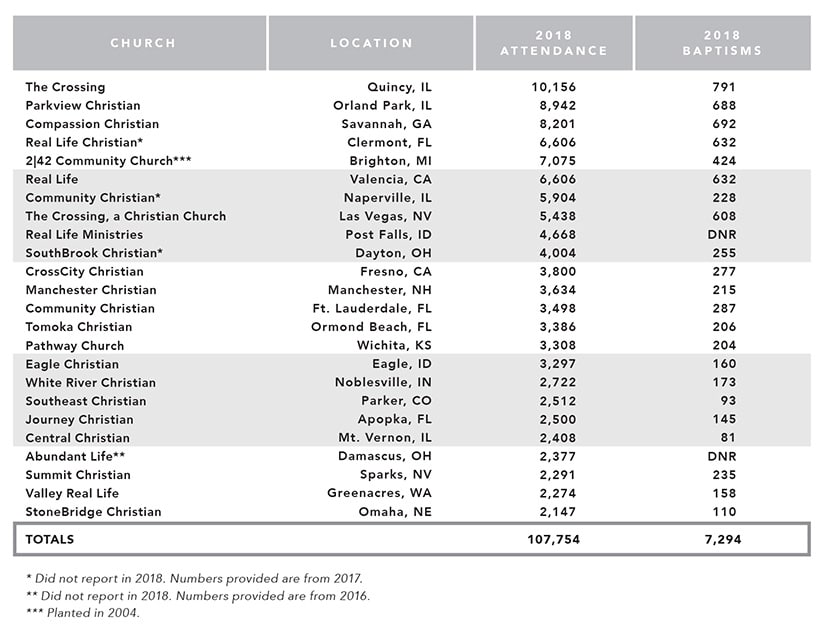What Independent Christian Churches Have to Celebrate . . . and the Challenges Ahead
We live in a world of polls describing a hopelessly post-Christian culture in which the church is constantly losing ground. A 2020 Gallup Poll found the number of Americans now affiliated with a church is just 47 percent, a sub-50 percent number for the first time in 80 years. Cary Nieuwhof shared a recent Barna/Stadia Poll that stated 30 percent fewer people in Generation Z (those born 1999 to 2015) attend church than baby boomers (those born 1946 to 1964). Another Barna study informed us that the number of practicing Christians dropped from 43 percent to 35 percent from 2000 to 2020. Lifeway Research reported that while 3,000 churches were planted in 2019, 4,500 closed. This list could go on and on. There is dismal news in just about every available category.
Now add to this data information about the damage COVID-19 has inflicted on the church, while also considering the “new normal” pundits are presenting. I agree that coronavirus sped up a lot of things that were already happening and that the church must respond with agility, but I still believe the church is alive, well, and ready to take new ground without giving up what had already been gained. Some would look back at all the polling and dismiss that kind of optimism.
But what if I could show you a different picture, something to celebrate rather than mourn over? While I can’t look at the entire landscape of churches in America, I do have a good vantage point from which to assess the health of independent Christian churches.
20 Years of Growth
Christian Standard has been chronicling attendance data of our megachurches for almost 25 years, and in the process of archiving the magazine, my attention was drawn to our first megachurch list. It was published in 1998 and reported 1997 numbers; however, it didn’t report total baptisms for each church. The next year the megachurch issue reported 1998 numbers, and it included baptism and transfer numbers. So, I thought it would be interesting to take the reports with 1998 and 2018 data, and compare the numbers from churches that reported in both issues over that 20-year span to see how they fared.
Of the 57 churches on that comprehensive list that averaged more than 1,000 for weekly worship during 1998, 46 reported their average attendance for 2018 (though in some cases we relied on 2016 or 2017 numbers), along with total number of baptisms and other data. Considering all the negative polling we leaders constantly hear, I found something very illuminating. Below is that list of the 46 churches (some have changed their names during the past two decades) along with attendance and baptism data so as to create a 20-year snapshot:
I saw this and was amazed at what God has done! Attendance for these 46 churches has grown by 148 percent during this period! And the number of baptisms for these churches grew 146 percent over these 20 years (factoring out churches that did not report baptisms one year or the other). But there’s more to this story.
Twenty-four independent Christian churches started below the 1,000 threshold in 1998 but skyrocketed in attendance to more than 2,000 by 2018, greatly increasing their total number of yearly baptisms in the process
These 24 churches now account for an average attendance of 107,754 and an additional 7,294 baptisms! That means a total of 345,347 people on average attend these 70 churches and that they grew their baptisms to more than 23,400 per year (even with some churches not reporting their baptism numbers).
Note that these lists don’t include churches that no longer report their numbers to Christian Standard (and haven’t for some time)—churches like Central in Las Vegas, Hillside in Amarillo, Texas, New Hope in Houston, and others. The lists also don’t include churches that have grown incredibly since 1998 but had not yet crossed the 2,000 threshold in 2018.
With all that in mind, I think it’s fair to say that in this 20-year period, while many other churches and denominations have been in decline, a large segment of independent Christian churches were increasing and experiencing nothing short of a renaissance in growth and evangelism. I don’t think there has been a time in our movement when we have experienced anything quite like this; the only era that might be comparable was the start of the Restoration Movement during the Second Great Awakening (the early 1800s). We have been experiencing an invisible renaissance in our movement, truly a movement of God, and it flies in the face of all the pollsters, forecasters, and fortune-tellers whose work might make us think we’re faltering or failing.
Jesus said the gates of Hades itself would not overcome the church he would build (Matthew 16:18). In a time when the church is trying to determine how to respond to the chaos of the last couple of years, it’s good to know the church is built on a firm foundation.
The Challenge Renaissance Creates
The real challenge our churches face isn’t numerical growth or evangelism, but how to develop its leadership. The issue is how to identify, develop, and improve our leadership pipelines so this thriving movement has enough shepherds. I see four main vehicles for achieving this:
- Our Bible colleges and Christian colleges
- Hiring from within our own churches
- Hiring staff from other churches within our movement
- Hiring with the help of headhunters in the greater evangelical movement
An investigative report in this issue examines the pipeline of leaders that come from the colleges and universities that identify with independent Christian churches. As I was researching this issue, I found that the total number of Christian ministry graduates from the top 16 schools offering these majors was very small. (By “Christian ministry graduates,” I mean students who earned a bachelor’s degree in preaching, theology, church leadership, Christian education, youth ministry, worship ministry, and/or church counseling.) The total amount of nondistance learning bachelor’s degrees (not master’s degrees or doctorates) from those top 16 schools for the 2019-20 school year was 406. That’s a drop in the bucket compared to the great need; the added concerns of educational costs and the debt students incur only compound the situation.
The largest pipeline of hiring in our movement today is from within the church; in some ways, that makes perfect sense. These new workers transition from volunteer roles within the church into paid full- and part-time staff positions, and from the secular world straight into ministry. The DNA of each church is baked into the new hire—which is great—but there is potentially a problem with the new paid church worker’s depth of biblical understanding, and with whether the church will offer any mechanism to compensate for that. The possibility of biblical drift is great.
Hiring from other churches within our movement is nothing new, but it doesn’t increase the number of leaders; it’s more like a game of musical chairs, with leaders moving from one location and ministry to another. It might help a leader realize their potential by moving to a new setting, but it does nothing to address the problem of too few leaders.
Finally, a growing number of churches now contract with headhunters like Slingshot or Vanderbloemen to fill their positional needs. These agencies perform a great service, but there is danger in widening the search base to evangelical churches and leaders who may not share or even know the distinctives of our movement. In our desire for talent, we might drift away from sound doctrine to something that sounds “close enough,” but which leaves much to be desired.
We in the independent Christian church are living in a time of great possibility, and while God has given us an incredible harvest in growth and evangelism over the last 20 years, we have never had a greater need for biblically literate practitioners to tend the flock and manage the harvest. Jesus taught us to pray to the Lord of the harvest to send out laborers into his field (Luke 10:2). Through Paul, he taught us to entrust the things we’ve learned into others who will also lead (2 Timothy 2:2). He told us to raise up and send out preachers (Romans 10:14-15).
The challenge before us now is to raise up “people of the Book,” people who know and rightly divide the word of truth (2 Timothy 2:15), people who sacrifice the oxen and burn the plow (1 Kings 19:21), people who say, “Here am I. Send me!” (Isaiah 6:8). We must be the generation that figures out a way to respond to the increasing width of our movement with a balance of not only more leaders but also leaders with spiritual depth. Only then will we become the good and faithful servants who are prepared to hear the Father say, “Well done.”




0 Comments